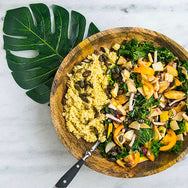By Linia Patel

There are an increasing number of types of milk available to consumers. Which one should you be drinking? Is organic milk the same as grass fed milk? How does cow’s milk differ from goat milk or almond or coconut milk? And what about the new A2 milk? Linia Patel, dietician and sports nutritionist, is here to help you navigate through the milky way.
cow milk
The most common variety of milk consumed is cow's milk. Cow's milk is available in a number of milk fat percentages: skim (fat free), 1%, 2% and whole (where no fat has been removed). As a general rule, nutrition experts recommend low-fat milk from two years onwards. Within my clinical practice (depending on nutritional goals), if you are consuming less than 1 pint of milk a day, I am increasingly open to the amount of fat you choose to have in your milk. For me the quality of the milk you consume is key.
does organic really make a difference?
The milk you drink will only be as healthy as the cow which produced it. Surveys suggest that people associate organic milk with superior nutrition. Organic farmers must use organic fertilizers and pesticides and may not must not give cows preventative antibiotics or supplemental growth hormones which may lower risk of contaminated feed. Studies have shown that organic milk contains at least 60% more omega-3 fatty acids than non-organic milk [1]. However, your choice should not stop at organic.
what is grass-fed milk?
Grass feeding is a practice not yet familiar to all consumers. 100% grass-fed cows’ milk comes from cows who have grazed in pasture (or eaten dry forage) all year around rather than being fed a processed diet of grains like corn and soya. Organic cows are not required to be solely grass fed however they must have at least 120 days per year of grazing. For the rest of the time organic cows can be fed grains. The natural diet for ruminant animals such as cattle is plain grass. Hard-to-digest grains radically alter the bacterial balance and composition in the animal’s gut. Just as humans, poor gut health in animals promotes disease and also radically alters the nutritional composition of the milk [2].
"The milk you drink will only be as healthy as the cow which produced it"
A recent study from Couvreur et al showed that grass-fed cows produced milk with 15% more healthy hearty omega-3 fats and 32% more conjugated linoleic acid (CLA). CLA is a type of fatty acid that is found naturally in milk primarily from ruminants such as cows. CLA exhibits potent antioxidant activity and some research indicates that CLA might be protective against heart disease, diabetes and cancer [2]. Grass fed cows milk had 22.9% more B12 and 18.7 % more iodine than grain fed cows, for example. The milk was also significantly richer in beta-carotene. Carotenoids, such as beta-carotene are precursors to vitamin A that are found as pigments in plants. Cows that eat carotenoid rich grass and forage therefore are able to incorporate significant amounts of these compounds with their tissue and therefore their milk [1].
A2 milk
Milk contains many proteins, one of which is called beta-casein. A1 and A2 are two common forms of beta-casein. Recent nutrition surveys show that 20% of the UK population struggle to digest milk protein. Milk labelled as A2 Milk contains mainly the A2 type of beta-casein. The milk currently available in supermarkets and known as ‘conventional milk’ contains a mixture of A2 and A1 beta casein (about 60% A2 and 40% A1). There is an emerging body of evidence implicating A1 beta casein in a range of human health conditions, many of which have an auto-immune element to them (i.e. Type 1 diabetes, heart disease, mental health conditions, child development) [3,4,5]. If you have a diagnosed milk protein intolerance or have a family history of auto-immune diseases you may want to consider A2 milk. However, one draw-back is that the A2 on the market is not organic or 100% grassfed.
Goat Milk
Goats milk is more easily digested by some as it contains smaller proteins and fat globules to those found in cows milk. It contains as much protein and calcium as cows milk and contains more tryptophan (an essential amino acid) than cows milk. However, goat’s milk still contains lactose, which will eliminate it as a choice for some [6]. It also has a very distinct taste which some may dislike.
Sheep Milk
Like goats’ milk, sheep’s milk has smaller proteins, smaller fat globules and more MCT’s which aids digestion. As sheep feed 100% on grass sheep milk has more CLA than the milk from cows or goats. Sheep milk also contain up to twice as much calcium, and B vitamins as cows or goats milk. However it contains as much lactose as cows milk so isn’t a great alternative if your lactose intolerant. One draw back of sheep’s milk is the cost. Sheep produce much less milk than cows and goats, hence sheep’s milk it is likely to be more expensive [7].
All milk that comes from an animal will contain some lactose sugar -- so, if you are lactose intolerant you may want to consider using a milk substitute from non-animal sources. These include as almond, rice or coconut milk for example. As the nutritional composition of these milk substitutes lack many of the key micronutrients contained in animal milk like calcium or vitamin D these milk substitutes are often fortified with nutrients to make them more marketable [7].
milk: a comparison
| Calories | Total Fat / g | Protein /g | Calcium / mg | |
| Cows whole | 147 | 8.1 | 7.9 | 276 |
| Cows skim | 86 | 0 | 8 | 276 |
| Goat | 169 | 10 | 9 | 327 |
| Sheep | 225 | 17 | 15 | 408 |
| Almond (fortified) | 60 | 2.5 | 1 | 288 |
| Rice (fortified) | 120 | 2 | 0.4 | 210 |
| Coconut (fortified) | 467 | 50.5 | 4.8 | 288 |
Source: Nutritics Professional Dietary Software
Almond milk from The Pressery
Almond milk
Almond milk is popular vegetarian alternative to those allergic to dairy or soy. Almond milk also has a naturally sweet taste. It terms of calcium content it is comparable to cows milk. On the downside, despite containing only 60 calories per cup almond milk is not a great protein source (1g per cup vs. 9g per cup in cow milk). It is also high in sugars. It is also not suitable for those with nut allergies and lacks the B vitamins in cow’s milk. If you do choose almond milk, go for one that is unsweetened and fortified with vitamin D [8,9].
Coconut milk
Coconut milk is another alternative to cows’ milk. It is lactose free and suitable for vegetarians and vegans. Coconuts are high in saturated fats, but the fats come from medium-chain triglycerides (MCT’s). MCT’s are fats with an unusual chemical structure that allows the body to digest them easily. These fats can be used immediately as an energy source. Coconut milk also contains a high level of potassium. The draw-backs to coconut milk are the low protein and calcium content and the high calorie count. One cup of coconut milk is approx. 450 calories, whereas a cup of whole milk is approx. 155kcal [7,8]. If you do choose coconut milk it is important that you consider coconut milk as a fat source rather than a protein source and – remember portion control!
Rice milk
Rice milk is another vegetarian/ vegan option that is also lactose free. It is made from ground rice and hence is naturally lower in protein and calcium in comparison to regular milk and higher in carbohydrates than cows’ milk. It is not recommended for children due to its low protein and calcium content [8,9]. If you are choosing rice milk, choose a variety that has been fortified with calcium and protein.
Linia's a leading dietitian and sports nutritionist, passionate about empowering people to better manage their health and optimise their performance through learning the essence of healthy eating. Visit her website here.
References




























































